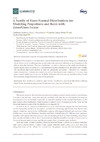Identificador persistente para citar o vincular este elemento:
https://accedacris.ulpgc.es/jspui/handle/10553/75499
| Campo DC | Valor | idioma |
|---|---|---|
| dc.contributor.author | Martínez-Flórez, Guillermo | en_US |
| dc.contributor.author | Leiva, Víctor | en_US |
| dc.contributor.author | Gómez-Déniz, Emilio | en_US |
| dc.contributor.author | Marchant, Carolina | en_US |
| dc.date.accessioned | 2020-11-12T20:41:01Z | - |
| dc.date.available | 2020-11-12T20:41:01Z | - |
| dc.date.issued | 2020 | en_US |
| dc.identifier.issn | 2073-8994 | en_US |
| dc.identifier.other | Scopus | - |
| dc.identifier.uri | https://accedacris.ulpgc.es/handle/10553/75499 | - |
| dc.description.abstract | In this paper, we consider skew-normal distributions for constructing new a distribution which allows us to model proportions and rates with zero/one inflation as an alternative to the inflated beta distributions. The new distribution is a mixture between a Bernoulli distribution for explaining the zero/one excess and a censored skew-normal distribution for the continuous variable. The maximum likelihood method is used for parameter estimation. Observed and expected Fisher information matrices are derived to conduct likelihood-based inference in this new type skew-normal distribution. Given the flexibility of the new distributions, we are able to show, in real data scenarios, the good performance of our proposal. | en_US |
| dc.language | eng | en_US |
| dc.relation.ispartof | Symmetry | en_US |
| dc.source | Symmetry [EISSN 2073-8994], v. 12 (9), 1439, (Septiembre 2020) | en_US |
| dc.subject | 5302 Econometría | en_US |
| dc.subject.other | Beta Distribution | en_US |
| dc.subject.other | Centered Skew-Normal Distribution | en_US |
| dc.subject.other | Maximum-Likelihood Methods | en_US |
| dc.subject.other | Monte Carlo Simulations | en_US |
| dc.subject.other | Proportions | en_US |
| dc.subject.other | R Software | en_US |
| dc.subject.other | Rates | en_US |
| dc.subject.other | Zero/One Inflated Data | en_US |
| dc.title | A family of skew-normal distributions for modeling proportions and rates with zeros/ones excess | en_US |
| dc.type | info:eu-repo/semantics/Article | en_US |
| dc.type | Article | en_US |
| dc.identifier.doi | 10.3390/sym12091439 | en_US |
| dc.identifier.scopus | 85091013315 | - |
| dc.contributor.authorscopusid | 55536045100 | - |
| dc.contributor.authorscopusid | 22953630400 | - |
| dc.contributor.authorscopusid | 15724912000 | - |
| dc.contributor.authorscopusid | 55094211400 | - |
| dc.identifier.eissn | 2073-8994 | - |
| dc.identifier.issue | 9 | - |
| dc.relation.volume | 12 | en_US |
| dc.investigacion | Ciencias Sociales y Jurídicas | en_US |
| dc.type2 | Artículo | en_US |
| dc.description.notas | This article belongs to the Special Issue Symmetric and Asymmetric Distributions: Theoretical Developments and Applications II | en_US |
| dc.utils.revision | Sí | en_US |
| dc.date.coverdate | Septiembre 2020 | en_US |
| dc.identifier.ulpgc | Sí | en_US |
| dc.contributor.buulpgc | BU-ECO | en_US |
| dc.description.sjr | 0,385 | |
| dc.description.jcr | 2,713 | |
| dc.description.sjrq | Q2 | |
| dc.description.jcrq | Q2 | |
| dc.description.scie | SCIE | |
| item.fulltext | Con texto completo | - |
| item.grantfulltext | open | - |
| crisitem.author.dept | GIR TIDES- Técnicas estadísticas bayesianas y de decisión en la economía y empresa | - |
| crisitem.author.dept | IU de Turismo y Desarrollo Económico Sostenible | - |
| crisitem.author.dept | Departamento de Métodos Cuantitativos en Economía y Gestión | - |
| crisitem.author.orcid | 0000-0002-5072-7908 | - |
| crisitem.author.parentorg | IU de Turismo y Desarrollo Económico Sostenible | - |
| crisitem.author.fullName | Gómez Déniz, Emilio | - |
| Colección: | Artículos | |
Citas SCOPUSTM
5
actualizado el 08-jun-2025
Citas de WEB OF SCIENCETM
Citations
6
actualizado el 12-ene-2026
Visitas
124
actualizado el 10-ene-2026
Descargas
88
actualizado el 10-ene-2026
Google ScholarTM
Verifica
Altmetric
Comparte
Exporta metadatos
Los elementos en ULPGC accedaCRIS están protegidos por derechos de autor con todos los derechos reservados, a menos que se indique lo contrario.
